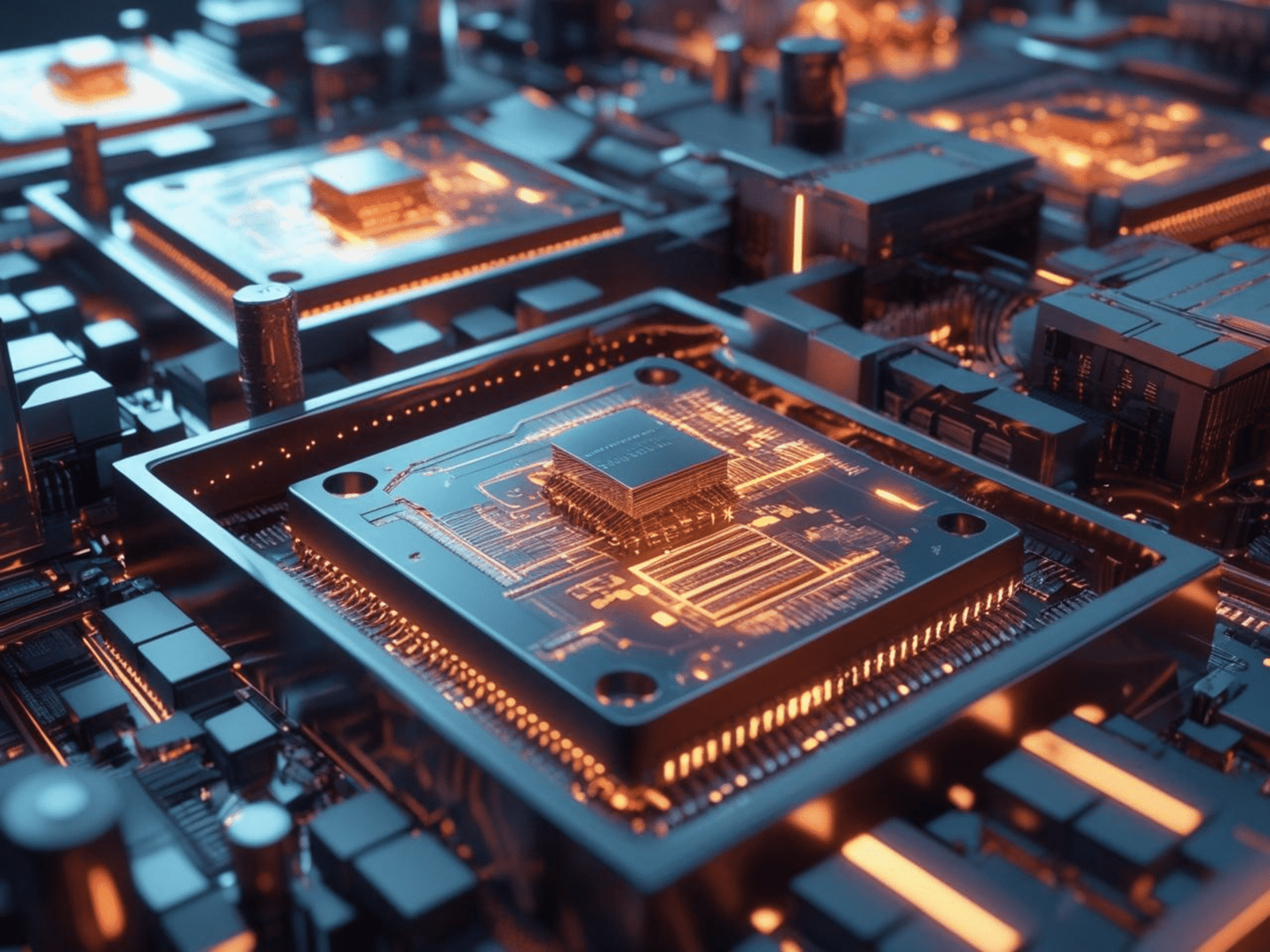Table of Contents
ToggleIntroduction to Microcontrollers and Microprocessors
Technology has revolutionized the way we live, and at the heart of most modern devices are microcontrollers and microprocessors. These tiny but powerful components act as the “brains” of electronic systems, enabling everything from basic household gadgets to advanced industrial machinery. While both play a crucial role in computing and automation, they differ in design, function, and application. Understanding them is the first step for anyone exploring the world of electronics and computer engineering.
What is a Microprocessor?
A microprocessor is an integrated circuit (IC) that primarily serves as the central processing unit (CPU) of a computer. It performs arithmetic and logic operations, processes instructions, and manages the flow of data between memory and peripheral devices.
Key Features of Microprocessors:
High processing power and speed.
Requires external components such as RAM, ROM, and input/output interfaces.
Designed for complex tasks like computing, multitasking, and running operating systems.
Common Applications
Desktop and laptop computers.
Smartphones and tablets.
Servers and high-performance systems.
Some well-known examples include Intel’s Core series, AMD Ryzen processors, and ARM processors used in mobile devices.
What is a Microcontroller?
A microcontroller (MCU) is a compact, self-contained system on a chip. Unlike microprocessors, it includes a CPU, memory (RAM and ROM), and input/output ports all integrated into a single chip. This makes microcontrollers ideal for dedicated, real-time applications.
Key Features of Microcontrollers
Low power consumption and compact size.
Cost-effective and easy to program.
Suitable for repetitive control tasks and automation.
Common Applications
Household appliances like washing machines, microwave ovens, and refrigerators.
Automotive systems such as airbags, engine control units, and parking sensors.
Embedded systems in IoT devices, robotics, and medical equipment.
Popular examples include Arduino (based on Atmel microcontrollers), PIC microcontrollers, and ARM Cortex-M series.
Microprocessor vs Microcontroller: A Comparison
| Feature | Microprocessor | Microcontroller |
|---|---|---|
| Integration | CPU only, needs external components | CPU + Memory + I/O on one chip |
| Cost | Generally higher | Cost-effective |
| Power Consumption | High | Low |
| Applications | General-purpose computing | Embedded and dedicated applications |
| Complexity | Handles complex tasks, multitasking | Handles simple, specific control tasks |
Why They Matter
Microprocessors and microcontrollers are the backbone of today’s digital world. Microprocessors power systems that demand heavy computing, while microcontrollers bring intelligence to everyday objects through automation. From smart homes and wearables to industrial robots and self-driving cars, these devices are shaping the future of technology.
Conclusion
In summary, microprocessors and microcontrollers are fundamental building blocks of modern electronics. While microprocessors are suited for powerful, complex computing, microcontrollers excel in embedded, task-specific applications. As industries evolve and the Internet of Things (IoT) expands, both will continue to play a vital role in innovation, efficiency, and automation.
The Role of Microcontrollers in Embedded Systems
In today’s technology-driven world, embedded systems form the backbone of countless devices we use daily — from smartphones and washing machines to automobiles and industrial robots. At the heart of these embedded systems lies a crucial component: the microcontroller. Microcontrollers serve as the “brains” of embedded systems, enabling automation, control, and efficient operation across a wide range of applications.
What is a Microcontroller?
A microcontroller (MCU) is a compact integrated circuit designed to perform specific control functions. It typically combines a processor (CPU), memory (RAM, ROM/Flash), and input/output (I/O) peripherals on a single chip. Unlike general-purpose microprocessors used in computers, microcontrollers are optimized for dedicated tasks within embedded systems.
Role of Microcontrollers in Embedded Systems
Control and Automation
Microcontrollers handle input signals from sensors and execute programmed instructions to control actuators, motors, displays, or other components. This makes them ideal for automating processes in appliances, smart devices, and industrial systems.
Efficient Resource Management
Since embedded systems often operate in constrained environments with limited power and memory, microcontrollers are designed to be power-efficient and resource-conscious. Many MCUs operate on low power and even include sleep modes to conserve energy, making them suitable for battery-operated devices.
Real-Time Processing
Embedded systems often need to respond to external events instantly, such as airbags deploying in a car or a thermostat adjusting temperature. Microcontrollers provide real-time response capabilities, ensuring precise and timely execution of tasks.
Connectivity and Communication
Modern microcontrollers come with built-in communication interfaces such as UART, SPI, I2C, CAN, and even wireless modules (Wi-Fi, Bluetooth). This enables embedded systems to interact with other devices, sensors, and networks, forming the backbone of the Internet of Things (IoT).
Customization and Flexibility
Microcontrollers can be programmed to perform highly specific tasks. This programmability allows engineers to tailor embedded systems for unique applications, whether in consumer electronics, automotive, healthcare, or aerospace industries.
Applications of Microcontrollers in Embedded Systems
Consumer Electronics : Televisions, microwaves, washing machines, and smart home devices.
Automotive Systems : Engine control units, airbag systems, anti-lock braking systems (ABS).
Industrial Automation : Robotics, process controllers, machine monitoring.
IoT Devices : Smart sensors, smart meters, home automation controllers.
Conclusion
Microcontrollers play a pivotal role in embedded systems by providing intelligence, control, and efficiency. Their versatility, low power consumption, and ability to operate in real time make them indispensable across various industries. As technology continues to evolve, microcontrollers are becoming even more powerful and integrated with advanced features, further expanding the potential of embedded systems.
Microcontrollers in IoT Devices
The Internet of Things (IoT) has become one of the most transformative technologies of the 21st century. From smart homes and wearable gadgets to industrial automation and healthcare monitoring, IoT devices are reshaping how humans interact with technology and the world around them. At the heart of these devices lies a small yet powerful component — the microcontroller (MCU). Microcontrollers play a crucial role in enabling connectivity, intelligence, and control in IoT systems.
What is a Microcontroller?
A microcontroller is a compact, low-power integrated circuit designed to perform specific tasks. It combines a processor (CPU), memory (RAM and ROM/Flash), and input/output peripherals on a single chip. Unlike general-purpose microprocessors used in computers, microcontrollers are optimized for embedded applications where energy efficiency, compactness, and real-time performance are essential.
Role of Microcontrollers in IoT Devices
Microcontrollers serve as the brains of IoT devices, handling everything from sensor data collection to wireless communication. Their key roles include:
Sensor Interfacing
IoT devices often rely on sensors to measure environmental parameters such as temperature, humidity, pressure, or motion. Microcontrollers capture and process this data, preparing it for further transmission or local decision-making.
Data Processing and Control
Many IoT applications require real-time decision-making, such as turning on a fan when the temperature rises. Microcontrollers process input data, run lightweight algorithms, and send control signals to actuators.
Connectivity
Modern microcontrollers integrate wireless communication modules such as Wi-Fi, Bluetooth, Zigbee, or LoRa. This allows IoT devices to connect seamlessly to cloud servers, smartphones, or local networks.
Low Power Operation
IoT devices often run on batteries or energy-harvesting systems. Microcontrollers are designed with ultra-low-power modes, enabling long-term deployment without frequent charging or maintenance.
Security
With the growing risk of cyberattacks, microcontrollers now include built-in security features such as encryption engines, secure boot, and authentication protocols to safeguard IoT data.
Popular Microcontrollers for IoT
Several microcontrollers are widely used in IoT development due to their versatility and power efficiency:
ESP32 / ESP8266 : Known for built-in Wi-Fi and Bluetooth, these MCUs are highly popular in DIY IoT projects.
ARM Cortex-M series : Used in industrial and commercial IoT applications due to their balance of performance and low power consumption.
Arduino Boards (ATmega328, SAMD21, etc.) : Favored by hobbyists, students, and researchers for rapid prototyping.
Raspberry Pi Pico (RP2040) : Affordable dual-core MCU with wide applications in IoT.
Applications of Microcontrollers in IoT
Smart Homes
Microcontrollers control smart lighting, thermostats, and appliances, improving convenience and energy efficiency.
Wearable Devices
Fitness trackers and smartwatches use MCUs to monitor health metrics and connect with smartphones.
Industrial IoT (IIoT)
Factories deploy IoT sensors with microcontrollers for predictive maintenance, process automation, and real-time monitoring.
Agriculture
Smart irrigation systems and environmental monitoring devices rely on microcontrollers to optimize resource usage.
Future of Microcontrollers in IoT
With IoT continuing to expand, microcontrollers are evolving to handle more advanced tasks. Emerging trends include:
AI on the edge : MCUs with machine learning capabilities to process data locally without cloud dependency.
Energy harvesting : Self-powered microcontrollers for ultra-low-maintenance IoT devices.
Stronger security : Hardware-level cryptography and trusted execution environments to protect sensitive IoT applications.
Conclusion
Microcontrollers are the backbone of IoT devices, bridging the gap between the physical and digital worlds. Their low power consumption, real-time processing, and built-in connectivity make them indispensable in creating efficient and intelligent IoT systems. As technology advances, microcontrollers will continue to evolve, enabling a smarter, more connected future.
Microprocessors in High-Performance Computing
High-Performance Computing (HPC) has revolutionized the way scientists, engineers, and researchers solve complex problems. From weather forecasting and climate modeling to advanced simulations in aerospace and medicine, HPC systems form the backbone of modern scientific and industrial innovation. At the heart of these powerful systems are microprocessors, which serve as the central processing units driving computation and efficiency.
Role of Microprocessors in HPC
Microprocessors are the brains of computing systems, designed to execute instructions, process data, and manage system operations. In HPC, microprocessors are optimized not just for general-purpose computing but for delivering massive parallelism, high throughput, and energy efficiency. Their role is critical in:
Performing trillions of calculations per second to solve highly complex equations.
Managing workloads efficiently across thousands of interconnected processors.
Balancing power consumption and heat management to ensure sustainable operations.
Evolution of Microprocessors for HPC
The journey of microprocessors in HPC has seen remarkable transformations:
Early Generations : Initially, microprocessors were designed for personal and business computing. Supercomputers relied on custom hardware and vector processors for specialized tasks.
Multi-Core Era : With the rise of multi-core processors, HPC systems gained the ability to run parallel tasks efficiently, significantly boosting computational performance.
Energy-Aware Designs : As power consumption became a bottleneck, energy-efficient microprocessors with smaller nanometer architectures and advanced cooling systems were developed.
Features of HPC Microprocessors
High Clock Speed and Core Count – Enables handling of intensive computations.
Vector Processing Capabilities – Allows simultaneous operations on multiple data points.
Scalability – Designed to work efficiently in clusters with thousands of nodes.
Large Cache Memory – Reduces latency in data access.
Interconnect Support – Facilitates fast communication between processors and memory systems.
Examples of Microprocessors in HPC
Intel Xeon and Xeon Phi Processors – Widely used in many top-ranked supercomputers for their reliability and parallel performance.
AMD EPYC Processors – Known for high core counts and excellent energy efficiency, contributing to many modern HPC systems.
IBM POWER Series – Designed for high memory bandwidth and AI integration, powering systems like Summit and Sierra.
ARM-Based Processors – Emerging as energy-efficient alternatives in exascale computing projects.
Challenges and Future Directions
While microprocessors have enabled tremendous growth in HPC, challenges remain:
Power and Cooling Requirements – High-density processors generate significant heat.
Cost of Development – Advanced architectures require heavy investments in R&D.
Software Optimization – Applications must be optimized to fully exploit microprocessor capabilities.
Looking ahead, microprocessors will continue to evolve with innovations such as quantum-inspired architectures, neuromorphic computing, and AI-driven processors. The rise of exascale computing (systems capable of performing a billion billion calculations per second) will rely heavily on microprocessor advancements that balance speed, scalability, and energy efficiency.
Conclusion
Microprocessors are the foundation of high-performance computing, enabling breakthroughs across scientific research, industrial applications, and national security. As demand for faster, more efficient computation grows, innovations in microprocessor design will determine the future of HPC, pushing the boundaries of what is computationally possible.



